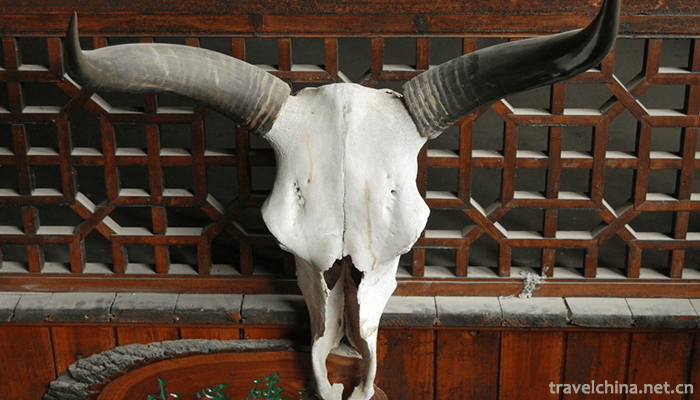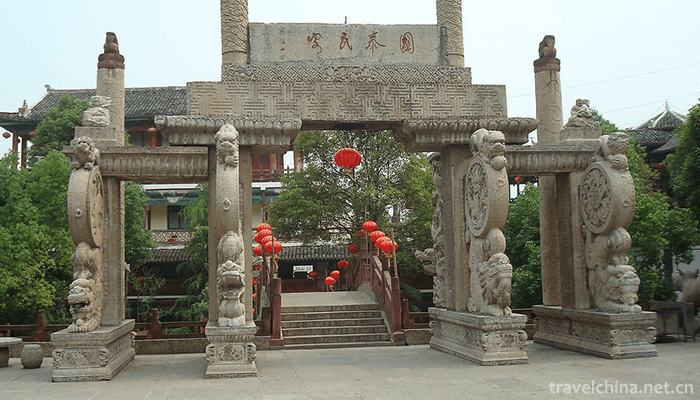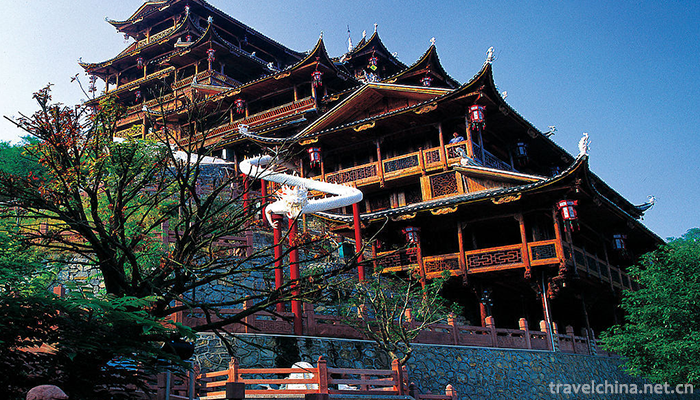Tujia Style Garden
Zhangjiajie Tujia Style Park is located in Zhangjiajie City, a beautiful pearl. The Park covers an area of more than 80 mu with a total investment of 75 million yuan. It is a large-scale comprehensive tourism service enterprise that integrates the humanistic landscape with the natural landscape and integrates tourism, literary and artistic performances, accommodation, catering, entertainment and shopping. The main projects are Tusi City and Bizka Hall of Torch. Tujia Custom Garden is mainly composed of Tujia Architectural Community, Folk Custom Display, Literary and Art Performance, Guest Room, Catering and other functional areas. In 2004, it was listed as the national AAAA-level tourist attractions, Zhangjiajie tourist boutique line.
brief introduction
Zhangjiajie Tujia Style Park is located in Zhangjiajie, a famous tourist resort in China. It covers an area of more than 80 mu with a total investment of 75 million yuan. The main projects are Tusi City and Bizka Holy Fire Hall (Evening Hall). The Tusi City, formerly Yongding Tusi City, is an ancient Tujia village, which was invested and renovated by private entrepreneur Mr. Yang Gangnian in 1999. There are intoxicating Tujia Lanmen wine in Tusi City. The mysterious activities of Tujia ancestor worship, the exhibition of Tujia historical relics, the demonstration of Tujia folklore, the "Nine Heavens" and the "Thousands of Maogues" are the two most colorful in the world, and the Tujia garden art is rich and colorful. Since its opening, the Tujia garden has attracted wide attention from all walks of life. It has received more than 20 party and state leaders to visit the Tujia garden, CCTV and so on. Many news media at home and abroad have also made special reports, which have received high praise. In 2004, it was listed as the national AAAA-level tourist attractions, Zhangjiajie tourist boutique line.
Service facilities
Tujia Custom Park is a large-scale comprehensive tourism service enterprise which integrates the humanistic landscape with the natural landscape. It integrates tourism, literary and artistic performances, rare exhibitions, accommodation, entertainment and shopping. Tujia Custom Garden is mainly composed of Tujia Architectural Community, Folk Custom Display, Literary and Art Performance, Guest Room, Catering and other functional areas. Its architecture is mostly wooden and stone structure, or carved beams and painted buildings, brilliant, or cornices, elegant and exquisite, representative works are Tusi Castle, Hand-swinging Hall, Tujia Mountain Village, Queen's Palace and so on. Especially the skyscraper, built by mountains, has a grand momentum. The building is designed by Li Hongjin, a 12-year-old Tujia youth with only elementary school education. It is 40 meters high, nine-fold and twelve-storey wooden pavilions, with a unique ingenuity.
The hotel is built according to three-star standard, with luxurious facilities and complete functions. There are more than 100 high, middle and low-grade rooms. The suspended rooms are unique and quiet.
The dining hall is mainly composed of the imperial dining hall and the large and small compartments of the Walking Horse Corner Tower, all of which are wooden structures and have another flavor. It can accommodate 300 people to eat at the same time. It is the reproduction of the original dietary culture. In addition, there are leisure tea service, which is convenient for tourists to enjoy the beautiful scenery and colorful literary and artistic programs while tasting tea.
Food introduction
All hotels and restaurants in Zhangjiajie City have delicately produced and barbecued mountain delicacies with unique flavor and strong national and local flavor.
Sour fish
Among the compatriots of Tujia and Miao nationalities, there is a kind of delicacy with unique local flavor, which is rarely known as "sour oxalis". What is "sour fish"? It is to wash the freshly caught fish, wrap them with rice flour (rice flour should be mixed with a little salt), and then put them in the vegetable jar, marinate for 3 to 5 days, and then dig them out with tea oil or other vegetable oil after they have sour taste, so that they are golden in color, sour and fragrant, and very delicious. "Sour Oxalis" can be taken out from the dish jar because it has been pickled for a long time and has been cooked by salt impregnation. "Sour Oxalis" is a famous dish served by ethnic minority compatriots, and the host family usually refuses to eat it unless the guest eats it.
Amolops ricketti
South China Turbulent Frog, also known as Stone Frog, is an amphibian frog family. It is a master of capturing water snakes. South China Turbulent Frog usually lives in a stream and stone pool, sometimes going ashore at night. It mated with grouper to produce offspring. South China Turbulent Frog can make "Bangbang" calls either day or night, so it is commonly known as "Bangbang". The meat of South China Turbulent Frog is very delicate and delicious, especially the soup, which is sweeter than chicken soup. It is rich in nutrients, is one of the precious foods, but also hospitality goods.
Quack chicken
Gaga Chicken, also known as Rock Chicken, belongs to Pheasant Family of Ornithology and is named for its "Gaga". Gaga chickens usually live in high mountains, but only when the weather is dark or sudden change, they fly up and down, and constantly emit "Gaga" calls to predict climate change. Gaga Chicken, a fat chicken, weighs 1.5 to 2.5 kilograms in general and 3.5 to 4.5 kilograms in large. Its meat is tender, delicious, nutritious, rich in flavor, much more fragrant than domestic chicken. It is a famous dish for drinking and one of the precious mountain delicacies.
Litsea cubeba
Litsea cubeba, known locally as "hot ginger" and "mountain pepper", is a seasoning for many foods. Litsea cubeba can eat fresh seeds or fry oil. The main components of the oil are limonene and methylheptanone. It can make all kinds of food, and can also be used as the essence of products such as cigarettes, cosmetics, toothpaste, soap and soap. It is also the best raw material for the synthesis of Vitamin A ionone fragrances. In particular, dumplings, rice flour or noodles, as long as a drop, will be fragrant and slightly spicy. Eat fresh fish, eel, loach and so on, drop one or two drops into the hot pot, there is a special aroma.
Loach Drill Tofu
"Loach drilling tofu" is a favorite dish of Tujia people. The cooking method is to put small loach in a jar or jar, pour clear water and put a small amount of salt into it, feed it overnight, wait for loach to spit out the mud and other impurities in its belly, then rinse it with clean water, and pour fresh loach into tender white tofu, let them drill randomly, drill out a few small holes of tofu, and then stew it in oil pan. Boiled with pepper, onion, monosodium glutamate, ginger powder, soy sauce and other condiments. This dish is rich in nutrition, especially fresh and tender, and its taste is very delicious. It is a delicious dish for Tujia people to entertain distinguished guests.
Lettuce from eel
Eel lettuce is fried with vegetable oil and fried glutinous rice first, and then into hot pot. When the soup is boiled, we eat eel lettuce next to eel. Here we go.
Sample, its delicious, but also one of the local flavor dishes.
In addition, the series of Tujia preserved vegetables include bacon pork, bacon mutton, bacon beef, bacon dog, bacon hoof, bacon sausage, bacon bean curd, etc. The series of sour and hot vegetables include sour wild clam, pickled cabbage, sour pork, sour fish, sour and hot corn paste, etc. The series of Tujia households include residue, pumpkin soup, rice tofu, steamed meat, buckled meat, stewed chicken with rock ear, boiled beancurd with loach, fish and spicy seeds, etc. Pickled meat, pickled fish, pickled pepper, pickled radish, pickled hot corn flour, pickled ginger, etc. Wild vegetables such as rice vegetable, wild pueraria powder, fern, Nanjin ginger can not be tasted.
Scenic Guide
Ticket: 120 yuan per person, discount ticket: 90 yuan per person
Preferential ticket object: for children less than 1.3 meters in height, tour guide certificate, travel agency manager qualification certificate, journalists with journalist confirmation line ticket exemption. Students over 1.3 meters in height, elderly people over 70 years of age with identity cards, active servicemen, disabled persons with valid certificates enjoy preferential prices.
Barbecue package ticket: 298 yuan.
Transportation:
Wuzipo, Nanzhuangping, Zhangjiajie, is a 5-minute drive from the city, only 10 minutes from the airport and railway station.
Arrangement of Scenic Spot Activities
1. 8:00-19:00 Tujia Lanmen Wine
Folk Custom Activities of Hand-waving Ground from 8:00 to 10:00
3. 10:00-10:20 Hand-waving Dance
Folk Custom Activities in Hand-waving Grounds from 10:20 to 16:00
Fifth, 16:00-16:30 Tujia people's ancestor worship activities
6. 16:30-18:30 Folk Custom Activities of Hand-waving Ground
7. All-day exhibitions of three stick drums, puppet show, land show, Tujia dwellings, weddings and wine workshop, oil press workshop, water mill, etc. (16 scenic spots in the park).
From 8:00 p.m. on August 8, March 8, to October 31, a large traditional Tujia festival, the Sabah Festival (a large set of bonfire barbecues).
Ninth, full-time narrators in the all-day garden accompany the tour scenic spots to explain.




0 Questions
Ask a Question
Your email address will not be published.